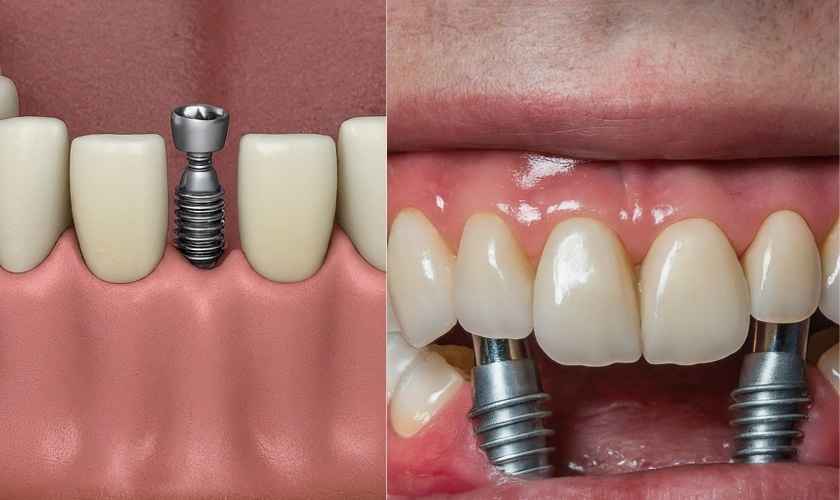The Best Strategy To Use For Dental Sense
The Best Strategy To Use For Dental Sense
Blog Article
Dental Sense - Questions
Table of ContentsThe Facts About Dental Sense UncoveredThe 8-Second Trick For Dental SenseNot known Details About Dental Sense Not known Facts About Dental Sense
are medical gadgets surgically implanted right into the jaw to recover an individual's capability to chew or their appearance. They provide support for artificial (phony) teeth, such as crowns, bridges, or dentures. When a tooth is shed as a result of injury or disease, an individual can experience difficulties such as quick bone loss, faulty speech, or modifications to chewing patterns that cause pain.Dental implant systems are composed of an oral implant body and dental implant joint and may also consist of a joint fixation screw. Kids dental. The dental implant body is operatively inserted in the jawbone in area of the tooth's root. The dental implant joint is normally affixed to the dental implant body by the abutment addiction screw and prolongs via gum tissues into the mouth to sustain the connected artificial teeth
(https://slides.com/dentalsense1)Framework of The Oral Implant System picking oral implants, speak to your dental supplier regarding the prospective benefits and risks, and whether you are a candidate for the treatment. Points to take into consideration: Your total wellness is a crucial consider establishing whether you are an excellent prospect for oral implants, for how long it will take to recover, and how much time the dental implant may remain in area.
Smoking might affect the healing process and reduce the long-lasting success of the implant. The recovery process for the dental implant body may take several months or longer, throughout which time you commonly have a momentary abutment instead of the tooth. the oral implant procedure: Meticulously comply with the oral health instructions offered to you by your dental company.
Getting My Dental Sense To Work
Implant failing can result in the requirement for another operation to repair or change the implant system. Brings back the capacity to chew Brings back aesthetic appearance Assists maintain the jawbone from shrinking due to bone loss Maintains the health of the surrounding bone and periodontals Aids keep nearby (close-by) teeth steady Boosts lifestyle Damage to surrounding natural teeth throughout dental implant positioning Injury to the surrounding cells during surgical treatment, such as sinus opening Injury throughout surgery (as an example, crack of bordering jawbone) Poor feature, such as seeming like the teeth do not bite together normally A sensation that the tooth hangs or twisting in area arising from an abutment screw loosening Implant body failure (looseness of the implant body) because of systemic infection, which might be extra most likely in people with uncontrolled diabetes due to local infection in bone and gums supporting the implant body due to delayed healing, which might be most likely in people that smoke Trouble cleaning the periodontals around the implant, leading to bad oral health Unattended gum condition Post-surgical feeling numb as a result of nerve impingement or damages Always notify health treatment service providers and imaging specialists that you have dental implants prior to any type of magnetic resonance imaging (MRI) or x-ray procedures.
FDA is not mindful of any kind of negative events reported for MRI or x-ray procedures with oral implants. Dental implants systems are usually made of products that adhere to worldwide consensus criteria of the International Organization for Standardization (ISO) or ASTM International. These criteria have details of what makes a safe product.

An oral implant is a framework that replaces a missing tooth. With screw-like devices, the specialist inserts a dental implant right into the jawbone, and it acts as an anchor for a synthetic tooth, called a crown.
About Dental Sense
Some people are not qualified for dental implant surgery. It is for oral cosmetic surgeons to operate on people with: acute illnessuncontrollable metabolic diseasebone or soft cells illness or infectionIf these problems Going Here are solved, an individual can have the surgical treatment. In, dental surgeons avoid from running on individuals with: If people with any of the above go through oral implant surgical procedure, there is a greater danger of the implant falling short.

Dental implant surgical treatment is a personalized process. It's not the very same for everyone. However the adhering to offers a general summary of what you can expect your dental practitioner, dental surgeon, periodontist or prosthodontist to do: Place the implant surgically. Give you time to heal. Attach the message and final crown, bridge or denture.
Next off, your doctor will thoroughly place the oral implant right into your jaw. If your implant is near the front of your mouth, your dentist will certainly make a momentary tooth for you to use until you heal.
The 9-Minute Rule for Dental Sense
Your copyright can tell you what to anticipate in your circumstance. Throughout the healing phase, your jawbone needs to fuse to the dental implant. This procedure, called osseointegration, is important for stability and long-lasting success. This procedure can take anywhere from 3 to nine months. In some situations, it might take longer.
When your dental implant heals, your dental expert can affix the abutment (tiny adapter article) and your final repair (crown, bridge or denture). This usually takes regarding one hour to finish and might require a second small surgical procedure. You shouldn't feel any type of discomfort throughout your oral implant procedure since your copyright will use medicine to numb your gum tissues.
Report this page